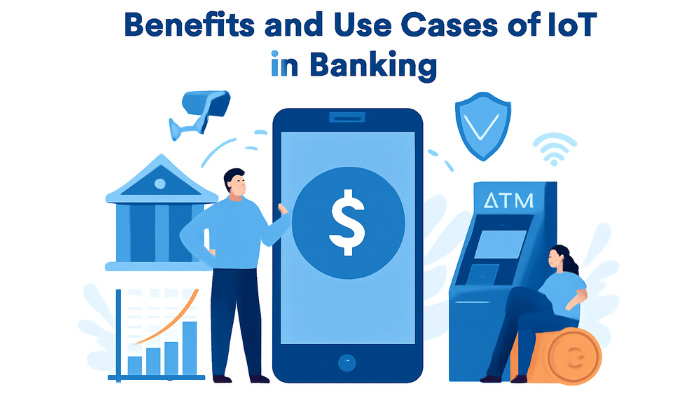Banks lose billions every year due to downtime, fraud, and slow service. Customers expect instant, secure, and personalized banking experiences but outdated systems often make that impossible. How can you maintain momentum when every delay or security breach erodes trust and revenue?
The use of IoT has grown across industries, and banking is no exception. In fact, the global Internet of Things market in banking is projected to surpass $90 billion by 2028.
With its ability to provide real-time data and seamless connectivity, IoT enables banks to improve customer support by quickly identifying issues and resolving them before they escalate. It speeds up services like transaction approvals and loan processing, reducing wait times for customers.
At the same time, IoT automates routine tasks and monitors systems continuously, easing the workload on staff and allowing them to focus on higher-value activities.
In this blog, we will break down exactly how IoT tackles the toughest challenges facing banking leaders and product teams today. You will see practical benefits and use cases that show why IoT is more than just a buzzword. It is a tool for real results.
What Is IoT in Banking
The Internet of Things, or IoT, refers to a network of connected devices that communicate and share data with each other. In banking, these devices include everything from ATMs and payment terminals to smartphones and wearable gadgets.
By linking these devices, banks can collect real-time data that helps improve service delivery, monitor systems, and enhance security. For example, IoT enables banks to track customer interactions across channels, identify service bottlenecks, and offer proactive support. This data also helps optimize workflows, allowing staff to focus on complex tasks while routine processes run automatically.
IoT in banking is about using connected technology to make everyday banking smoother, safer, and more responsive to customer needs.
Understanding what IoT means for banking is just the first step. The real question is, how does this technology improve the way banks operate and serve their customers?
Let’s explore the key benefits IoT brings to the banking world.
Benefits of IoT in Banking
For banking leaders, product managers, and decision-makers, IoT offers several clear advantages that directly address daily challenges and goals.
1. Proactive Issue Detection and Faster Resolution
IoT devices constantly monitor banking equipment such as ATMs, payment terminals, and network infrastructure. They collect data in real time and alert your operations or maintenance teams as soon as something seems off. This proactive monitoring means banks can fix problems before they affect customers, avoiding costly downtime and improving service reliability.
2. Personalized and Data-Driven Customer Engagement
IoT generates detailed insights about customer behaviors through connected devices like smartphones, wearables, and in-branch sensors. Banks can analyze this data to tailor products and offers to individual customer needs, making interactions more relevant and increasing customer loyalty.
3. Enhanced Security with Biometric and Device-Based Authentication
IoT supports advanced security measures by using biometrics and device identification. Connected wearables, fingerprint scanners, and facial recognition systems allow banks to verify identities with higher accuracy and lower friction. This reduces fraud risk and builds trust with customers.
4. Automation of Operational Tasks to Boost Efficiency
Banks handle many routine tasks such as ATM cash management, equipment monitoring, and branch maintenance. IoT automates these processes by tracking inventory, detecting equipment failures, and notifying staff in real time. Automation reduces manual effort, speeds up workflows, and cuts operational costs.
5. Real-Time Analytics for Smarter Product and Service Decisions
IoT devices provide continuous streams of data about how customers use banking services. Product and business leaders can analyze this data to identify pain points, popular features, and opportunities for improvement. This insight helps banks launch better products and adapt quickly to customer needs.
6. Cost Savings Through Energy and Resource Management
IoT devices help banks manage energy consumption and other resources efficiently. Smart sensors can control lighting, heating, and cooling systems in branches based on occupancy and time of day. This reduces unnecessary energy use, lowering operational expenses without sacrificing comfort or security.
7. Improved Compliance and Risk Monitoring
Banks face strict regulatory requirements and must monitor risks continuously. IoT devices can track how sensitive assets and data move within branches or data centers. Real-time alerts flag any unusual activities or non-compliance, helping risk and compliance teams act quickly.
8. Enhanced Employee Productivity and Focus
By automating routine checks and maintenance alerts, IoT frees employees from manual monitoring tasks. Staff can concentrate on high-value work like customer service and strategy. This improves overall productivity and job satisfaction.
9. Support for Contactless and Remote Banking
IoT technologies enable seamless contactless payments and remote banking services. Customers can securely make transactions via smartphones, wearables, or other connected devices, reducing the need for physical interaction, a crucial feature in today’s environment.
10. Faster and Smarter Emergency Response
IoT sensors can detect emergencies like fires, floods, or equipment failures in branches or data centers. These sensors send instant alerts to relevant teams for immediate action, minimizing damage and ensuring safety.
Secure Your IoT Banking Infrastructure Today
You’ve seen how IoT can solve real problems and boost your banking operations. But what does that actually look like day to day?
Let’s jump into some real-world examples of IoT in action so you can picture exactly how these tools can work for your team and customers.
Real-World Use Cases of IoT in Banking
IoT is helping banks work better and serve customers faster. By connecting systems and using real-time data, banks can make processes easier, cut down on manual work, and give customers more personal service. Here are some real ways IoT is changing banking today.
Smart ATMs with Remote Monitoring
ATMs can be frustrating when they run out of cash or face technical issues. IoT sensors keep an eye on cash levels and machine health all the time. When something needs attention, your operations team gets an instant alert. This way, banks can fix problems quickly and keep ATMs running smoothly, making sure customers don’t face downtime.
Example: Many leading banks now use connected sensors in their ATM networks to monitor performance remotely. This helps them schedule maintenance ahead of time and provide reliable service without waiting for customer complaints.
Personalized Banking Through Connected Devices
Banks gather data from smartphones, wearables, and other connected gadgets to understand customer habits better. This data lets banks offer personalized services like customized loan options or rewards that fit a customer’s lifestyle. The result is a more engaging and relevant banking experience that keeps customers coming back.
Example: Some banks track mobile app usage patterns to offer timely financial advice or targeted promotions, helping customers make smarter money decisions while boosting loyalty.
Enhanced Security with Biometric Devices
Security is always top of mind for banks and customers alike. IoT enables the use of biometric devices like fingerprint scanners and facial recognition on smartphones and wearables. These connected tools verify identities quickly and accurately, making it harder for fraudsters to break in while keeping the login process smooth for users.
Example: Several banks have adopted biometric authentication on mobile apps and wearables, reducing fraud incidents and building customer trust without adding extra steps to their experience.
Automation of Cash Management and Equipment Monitoring
Managing cash levels in ATMs and monitoring branch equipment used to require manual checks that took time and resources. With IoT, sensors track cash availability and equipment health continuously. When cash runs low or a device needs attention, staff get instant notifications. This automation helps prevent cash shortages and unexpected breakdowns, keeping operations running smoothly.
Example: Banks use IoT sensors to automatically monitor ATM cash and alert teams when refills are needed. This reduces emergency restocking and improves customer satisfaction by ensuring machines stay operational.
Contactless Payments and Wearable Banking
With IoT, customers can make quick, secure payments using devices like smartwatches and smartphones without touching cash or cards. This technology not only speeds up transactions but also adds a layer of safety, especially in today’s health-conscious world. It lets banks offer convenient, modern payment options that meet customer expectations.
Example: Many banks now support contactless payments through wearables and mobile devices, making everyday purchases seamless and secure for their customers.
Real-Time Fraud Detection and Prevention
IoT devices help banks detect unusual behavior by monitoring transactions and device activity in real time. If a customer’s card is used from an unexpected location or a device shows suspicious patterns, the system can flag it immediately. This allows banks to act quickly, blocking fraudulent transactions before they cause damage.
Example: Banks use IoT-powered monitoring to track spending patterns and device locations. When something seems off, they send instant alerts to customers and freeze suspicious activity, protecting both the bank and its clients.
Optimized Branch Management with IoT
IoT sensors help banks manage their physical branches more efficiently. They monitor everything from foot traffic and queue lengths to temperature and lighting. This data helps managers improve customer flow, reduce wait times, and create a more comfortable environment, making visits smoother and more enjoyable.
Example: Some banks use IoT to track how many people enter and move through branches. They adjust staff schedules and service points based on real-time data, reducing crowding and wait times during peak hours.
Mobile Banking Chatbots Powered by IoT Data
IoT devices collect real-time data about customer behavior and preferences. Banks use this information to power mobile banking chatbots that offer personalized, timely support. These chatbots can answer questions, guide users through transactions, and even suggest relevant products, all without needing human intervention.
Example: A bank integrated IoT data with its chatbot, enabling it to recognize when a customer is facing trouble with a transaction or needs account information. The chatbot then provides instant, tailored help, improving customer satisfaction and reducing call center loads.
Solve slow processes and reduce risks with smart IoT solutions.
We’ve seen how IoT is already reshaping banking today, but the story doesn’t end here. New technologies and creative applications are on the horizon, promising to take banking to a whole new level.
Let’s explore some exciting IoT trends that could change the way banks and customers interact in the near future.
Emerging IoT Use Cases Shaping the Future of Banking
New IoT applications are changing how banks operate and serve their customers. These emerging use cases are helping banks become faster, safer, and more efficient, setting the stage for the future of banking.
1. Augmented Reality (AR) Banking Experiences
Future IoT applications could bring augmented reality into banking. Imagine customers using AR glasses or apps to visualize their spending, investments, or loan options in real time, layered over their environment. This tech would make complex financial information easier to understand and interact with.
Example: A customer wearing AR glasses could walk into a branch and see personalized offers, account summaries, or even virtual assistants guiding them through services.
2. Blockchain-Enabled IoT for Secure Transactions
Combining IoT with blockchain technology will add extra security and transparency to banking transactions. IoT devices can automatically record transaction data on a blockchain, reducing fraud and improving auditability.
Example: IoT sensors could track asset transfers or loan repayments and log each event securely on a blockchain ledger accessible by authorized parties.
3. AI-Powered Predictive Financial Advice
By collecting data from IoT devices, banks can use AI to predict financial needs and offer proactive advice. For instance, wearable health data combined with spending patterns might allow banks to suggest insurance products or savings plans tailored to a customer’s lifestyle.
Example: An AI system might detect changes in a customer’s daily routine and recommend adjusting budgets or applying for specific financial products before problems arise.
4. Smart Contracts Triggered by IoT Events
Smart contracts—self-executing agreements—could be triggered by IoT data. For example, loan disbursements or insurance payouts could automatically occur when IoT sensors confirm conditions are met.
Example: In agriculture financing, IoT sensors monitoring crop health could trigger automatic insurance claims if damage is detected.
Also Read: Emerging IoT Trends and Technologies to Watch in 2025
You’ve seen the potential of IoT, and maybe you’re wondering, how do we get this off the ground without hitting roadblocks? We know IoT isn’t always easy, but with the right steps, you can turn those possibilities into real wins.
Here’s a practical roadmap to guide banking leaders and product teams through a smooth IoT rollout.
A Practical Roadmap for IoT Implementation in Banking
Implementing IoT in banking requires careful planning and coordination across teams. This roadmap outlines key steps to help banking leaders and product teams roll out IoT solutions smoothly, maximize benefits, and minimize risks.
Following this guide ensures your bank stays ahead in delivering faster, safer, and more efficient services.
1. Define Clear Objectives
Before starting your IoT journey, it’s important to decide what you want to achieve. Having clear goals helps everyone stay focused and allows you to measure success properly.
Ask yourself:
- What problems need fixing right now? For example, frequent ATM breakdowns or slow fraud detection?
- What benefits do you want to see? Faster service, happier customers, fewer security breaches?
- How will these goals support your bank’s overall mission and growth plans?
Getting input from different teams, like operations, IT, security, and customer service makes sure your objectives cover all important areas. Setting specific goals such as “reduce ATM downtime by 20%” or “detect fraud in under 10 minutes” helps track progress and keep everyone aligned.
Clear objectives also make it easier to decide which IoT solutions will be most effective and where to focus your investment.
2. Check Your Current Systems
Next, take a close look at the technology you already have. IoT devices need reliable networks, enough storage, and strong security to work well. Older systems might struggle to keep up.
Consider:
- Does your current network support continuous, real-time data from many devices?
- Is your data storage and processing fast and scalable enough for IoT?
- Can your security systems protect against new risks that come with connected devices?
- How easily can your existing systems integrate with new IoT tools?
Identifying gaps now means you can upgrade or replace parts of your system before launching IoT. This reduces the chance of delays, failures, or security problems down the line.
3. Pick the Right Technology and Partners
Choosing the right IoT devices, platforms, and partners is key to success. Not every solution fits all banks, so look carefully at what matches your needs.
Things to check:
- Does the technology meet banking regulations and data privacy laws?
- Is the system scalable so you can add more devices or features later?
- How well does it connect with your existing software and hardware?
- Does the vendor understand banking and fintech challenges?
- Can they provide ongoing support and updates?
Working with experienced partners who know the industry helps you avoid common mistakes. They can guide you through compliance requirements, security best practices, and integration challenges.
4. Build Security and Compliance In
Security must be part of every step in your IoT project. Adding devices and data streams increases your risk if not managed properly.
Make sure you:
- Verify every IoT device before it connects to your network to block unauthorized access.
- Encrypt all data sent between devices and your systems to keep information safe.
- Continuously monitor device activity to spot suspicious behavior fast.
- Follow all banking and data privacy regulations like GDPR and PCI-DSS to protect customers and avoid penalties.
- Regularly test your systems with penetration testing and audits to find and fix weaknesses.
Strong security reduces risks and builds trust with customers and regulators.
5. Start Small with a Pilot
Trying to do everything at once can lead to failures and wasted money. Start with a small pilot project in a limited area like a few ATMs or a single branch.
Benefits of pilots:
- Test if the technology works well in real-world conditions.
- Identify technical or user issues early before full rollout.
- Collect feedback from employees and customers to improve the solution.
- Measure results using clear performance indicators to decide if you should expand.
- Build support across your teams by showing early wins.
Pilots let you adjust your plan and fix problems before investing heavily.
6. Grow Step-by-Step and Watch Closely
Once your pilot succeeds, expand IoT deployment gradually. Don’t rush to cover everything at once.
Key points as you scale:
- Monitor devices constantly to detect faults or security threats immediately.
- Use data analytics to improve efficiency, customer experience, and product offerings.
- Set up a dedicated team or center of excellence to manage IoT projects and keep them on track.
- Regularly review progress against your initial goals and adjust as needed.
- Keep communication flowing between teams to quickly solve issues.
Growing step-by-step with careful oversight helps keep quality high and reduces surprises.
7. Train Your Team and Keep Them Informed
People are central to IoT success. If your staff don’t understand or trust the technology, adoption will suffer.
Make training a priority:
- Explain how IoT tools will make daily work easier and benefit the bank overall.
- Provide simple, hands-on training sessions and resources.
- Share success stories and improvements to keep motivation high.
- Maintain ongoing support and clear communication during and after rollout.
Well-trained and informed teams adapt faster and contribute more to IoT’s success.
8. Keep Customers at the Center
IoT investments pay off when they improve customer experiences. Use IoT data to:
- Personalize services and offers based on real customer behavior.
- Reduce wait times and simplify processes like payments and support.
- Enhance security while making access easy and smooth.
- Gather customer feedback and adjust your services accordingly.
Focusing on customers builds loyalty and encourages growth.
9. Stay Ready for Future Technology
IoT and related tech evolve quickly. Planning for the future means you can take advantage of new innovations without costly overhauls.
To prepare:
- Keep track of emerging technologies like AI, blockchain, or augmented reality.
- Build flexible systems and partnerships that can adapt to change.
- Train your teams continuously to keep skills up to date.
Being ready for what’s next helps your bank stay competitive and meet changing customer needs.
If banking leaders or product managers are considering IoT for their operations, the key is having a trusted partner who understands both the technology and the banking world. That’s where Codewave comes in.
Codewave’s IoT Solutions for Banking Success
At Codewave, we don’t just deliver IoT devices or software; we build tailored IoT solutions designed to tackle your specific banking challenges. Whether it’s improving ATM uptime, strengthening security, or personalizing customer experiences, we combine deep fintech expertise with advanced technology to drive real results.
Our approach includes:
- Custom IoT App Development: We create secure, scalable apps that connects your banking systems and devices, ensuring seamless data flow and reliable performance.
- Cloud Integration and Migration: Our cloud services help you modernize your infrastructure, making it easier to manage IoT data and scale operations efficiently.
- Data Analytics and AI Solutions: We harness real-time data from IoT networks to provide actionable insights that enhance customer support, fraud detection, and operational efficiency.
- Pilot Management and Full-Scale Deployment: From initial testing to large-scale rollouts, we guide you through every phase with minimal disruption and maximum impact.
- Ongoing Support and Optimization: Our team offers continuous monitoring, updates, and training to keep your IoT ecosystem secure and effective.
With experience in fintech and digital transformation across multiple countries, Codewave offers the expertise and hands-on approach banking leaders need to succeed with IoT. If you’re ready to explore how IoT can reshape your banking services, we’re here to help you every step of the way.
Codewave is a UX first design thinking & digital transformation services company, designing & engineering innovative mobile apps, cloud, & edge solutions.







